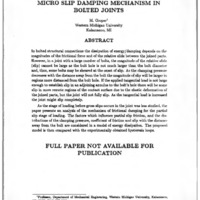-
Title
-
Micro Slip Damping Mechanism In Bolted Joints
-
Report Number
-
WL-TR-91-3078 Volume III, p. JBB-1
-
Creator
-
Groper, M.
-
Corporate Author
-
Western Michigan University
-
Date
-
1991
-
Date Issued
-
1991-08
-
Extent
-
1
-
Identifier
-
ADA241313
-
Format
-
1 online resource
-
Abstract
-
ln bolted structural connections the dissipation of energy/ damping depends on the
magnitudes of the frictional force and of the relative slide between the joined parts.
However, in a joint with a large number of bolts, the magnitude of the relative slide
(slip) cannot be large as the bolt hole is not much larger than the bolt diameter
and, thus, some bolts may be sheared at the onset of slip. As the clamping pressure
decreases with the distance away from the bolt the magnitude of slip will be larger in
regions more distanced from the bolt hole. If the applied tangential load is not large
enough to establish slip in an adjoining annulus to the bolt's hole there will be some
slip in more remote regions of the contact surface due to the elastic deformation of
the joined parts, but the joint will not fully slip. As the tangential load is increased
the joint might slip completely.
As the stage of loading before gross slips occurs in the joint was less studied, the
paper presents analysis of the mechanism of frictional damping for the partial slip stage of loading. The factors which influence partial slip friction, and the distributions
of the clamping pressure, coefficient of friction and slip with the distance
away from the bolt are considered in a model of energy dissipation. The proposed
model is then compared with the experimentally obtained hysteresis loops.
FULL PAPER NOT AVAILABLE FOR
PUBLICATION
-
Description
-
ln bolted structural connections the dissipation of energy/ damping depends on the
magnitudes of the frictional force and of the relative slide between the joined parts.
However, in a joint with a large number of bolts, the magnitude of the relative slide
(slip) cannot be large as the bolt hole is not much larger than the bolt diameter
and, thus, some bolts may be sheared at the onset of slip. As the clamping pressure
decreases with the distance away from the bolt the magnitude of slip will be larger in
regions more distanced from the bolt hole. If the applied tangential load is not large
enough to establish slip in an adjoining annulus to the bolt's hole there will be some
slip in more remote regions of the contact surface due to the elastic deformation of
the joined parts, but the joint will not fully slip. As the tangential load is increased
the joint might slip completely.
As the stage of loading before gross slips occurs in the joint was less studied, the
paper presents analysis of the mechanism of frictional damping for the partial slip stage of loading. The factors which influence partial slip friction, and the distributions
of the clamping pressure, coefficient of friction and slip with the distance
away from the bolt are considered in a model of energy dissipation. The proposed
model is then compared with the experimentally obtained hysteresis loops.
FULL PAPER NOT AVAILABLE FOR
PUBLICATION
-
Distribution Classification
-
1
-
Distribution Conflict
-
No
-
DTIC Record Exists
-
No
-
Illinois Tech Related
-
No
-
Photo Quality
-
Not Needed
-
Report Availability
-
Full text available
-
Type
-
article
 articleJBB
articleJBB